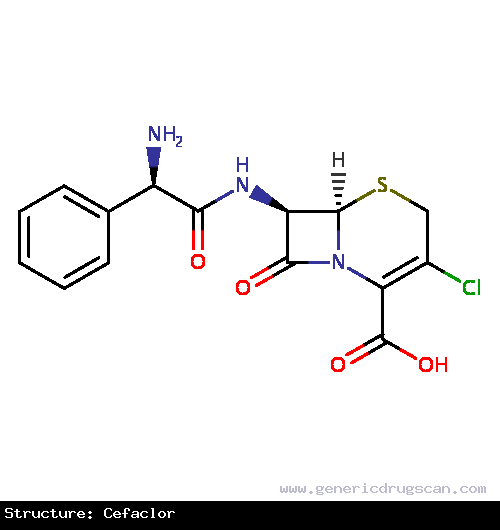Cefaclor Drug: Indication, Dosage, Precaution, Side Effect , Storage, Category Type and corresponding Brands - www.genericdrugscan.com
Cefaclor
Drug Status in USA : ApprovedDrug Status in Canada : Approved
pronunciation
pronounced as (sef' a klor)
Why is this medication prescribed?
Cefaclor is used to treat certain infections caused by bacteria, such as pneumonia and other lower respiratory tract (lung) infections; and infections of the skin, ears, throat, tonsils, and urinary tract. Cefaclor is in a class of medications called cephalosporin antibiotics. It works by stopping the growth of bacteria.
Antibiotics such as cefaclor will not work for colds, flu, or other viral infections. Using antibiotics when they are not needed increases your risk of getting an infection later that resists antibiotic treatment.
How should this medicine be used?
Cefaclor comes as a capsule, an extended-release (long-acting) tablet, and a suspension (liquid) to take by mouth. The capsule and liquid are usually taken with or without food every 8 or 12 hours . The long-acting tablet is usually taken within 1 hour of eating a meal every 12 hours (twice a day) for 7 to 10 days . Take cefaclor at around the same times every day. Follow the directions on your prescription label carefully, and ask your doctor or pharmacist to explain any part you do not understand. Take cefaclor exactly as directed. Do not take more or less of it or take it more often than prescribed by your doctor.
Shake the suspension well before each use to mix the medication evenly.
Swallow the long-acting tablets whole; do not split, chew, or crush them.
You should begin to feel better during the first few days of treatment with cefaclor. If your symptoms do not improve or get worse, call your doctor.
Take cefaclor until you finish the prescription, even if you feel better. If you stop taking cefaclor too soon or skip doses, your infection may not be completely treated and the bacteria may become resistant to antibiotics.
What are the precautions to be followed?
Before taking cefaclor,- tell your doctor and pharmacist if you are allergic to cefaclor, other cephalosporin antibiotics such as cefadroxil , cefazolin (Ancef, Kefzol), cefdinir , cefditoren (Spectracef), cefepime (Maxipime), cefixime (Suprax), cefotaxime (Claforan), cefotetan, cefoxitin (Mefoxin), cefpodoxime , cefprozil (Cefzil), ceftaroline (Teflaro), ceftazidime ( Fortaz, Tazicef, in Avycaz), ceftibuten (Cedax), ceftriaxone (Rocephin), cefuroxime (Ceftin, Kefurox, Zinacef), and cephalexin (Keflex); penicillin antibiotics; or any other medications. Also tell your doctor if you are allergic to any of the ingredients in cefaclor capsules, extended release tablets, or suspension. Ask your pharmacist for a list of the ingredients.
- tell your doctor and pharmacist what prescription and nonprescription medications, vitamins, nutritional supplements, and herbal products you are taking or plan to take. Be sure to mention either of the following: anticoagulants ('blood thinners') such as warfarin (Coumadin, Jantoven), and probenecid (Probalan). Your doctor may need to change the doses of your medications or monitor you carefully for side effects.
- tell your doctor if you have or have ever had any kind of allergies, gastrointestinal disease (GI; affecting the stomach or intestines), especially colitis (condition that causes swelling in the lining of the colon
- large intestine
- if you are taking antacids that contain magnesium or aluminum, take them 1 hour before or 1 hour after cefaclor extended release tablets.
- tell your doctor if you are pregnant, plan to become pregnant, or are breastfeeding. If you become pregnant while taking cefaclor, call your doctor.
What are possible side effects of this medication ?
Cefaclor may cause side effects. Tell your doctor if any of these symptoms are severe or do not go away:- diarrhea
- nausea
- vomiting
- stomach pain
- headache
- genital itching
- rash
- itching, prickling, burning, or stinging feeling on the skin
- hives
- difficulty breathing or swallowing
- wheezing
- swelling of the face, throat, tongue, lips, eyes, arms or legs
- lack of energy, or feeling faint
- joint pain
- watery or bloody stools, stomach cramps, or fever during treatment or for up to two or more months after stopping treatment
- a return of fever, sore throat, chills, or other signs of infection
Cefaclor may cause other side effects. Call your doctor if you have any unusual problems while taking this medication.
How to store the medication and dispose it of after its use later?
Keep this medication in the container it came in, tightly closed, and out of reach of children. Store the capsules and tablets at room temperature and away from excess heat and moisture (not in the bathroom). The tablets should also be stored away from light. Keep liquid medicine in the refrigerator, tightly closed, and dispose of any unused medication after 14 days.
Unneeded medications should be disposed of in special ways to ensure that pets, children, and other people cannot consume them. However, you should not flush this medication down the toilet. Instead, the best way to dispose of your medication is through a medicine take-back program.
Drug Category/Class
- Anti-Bacterial Agents
- Cephalosporins
- Second-Generation Cephalosporins
- Antibacterials for Systemic Use
- Antiinfectives for Systemic Use
- Second-generation cephalosporins
| Prescribed | For the treatment of certain infections caused by bacteria such as pneumonia and ear, lung, skin, throat, and urinary tract infections. |
| Weight : | 367.807 |
| Structure | Cefaclor |
 | |
| Formula | C15H14ClN3O4S |
Cefaclor has 102 Brands listed
Search Generic Drugs alphabetically
